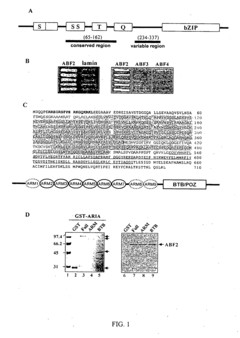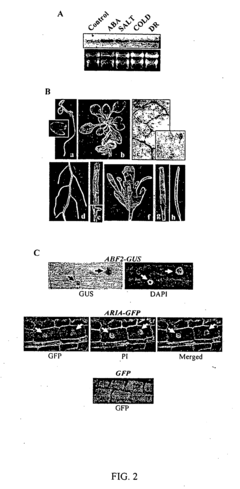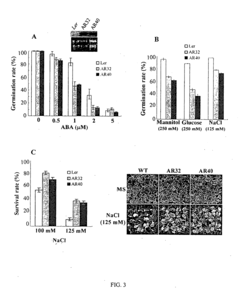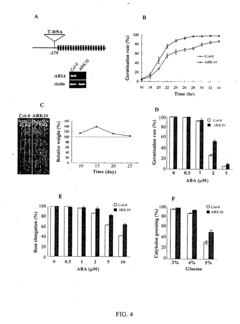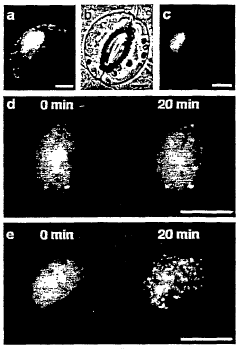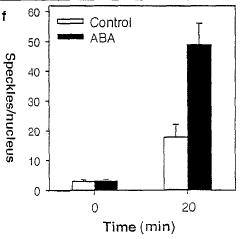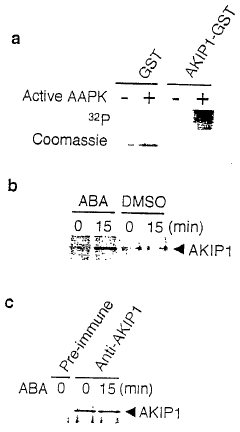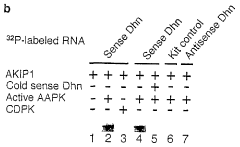How Abscisic Acid Modulates Plant Growth Under Stress?
JUL 14, 20258 MIN READ
Generate Your Research Report Instantly with AI Agent
Patsnap Eureka helps you evaluate technical feasibility & market potential.
ABA Stress Response
Abscisic acid (ABA) plays a crucial role in plant stress response mechanisms, acting as a key phytohormone that modulates various physiological and molecular processes. When plants encounter environmental stresses such as drought, salinity, or extreme temperatures, ABA levels rapidly increase, triggering a cascade of signaling events that lead to adaptive responses.
The ABA-mediated stress response begins with the perception of ABA by receptor proteins, primarily the PYR/PYL/RCAR family. Upon binding ABA, these receptors undergo conformational changes that enable them to interact with and inhibit protein phosphatases of the PP2C family. This inhibition releases SNF1-related protein kinases (SnRK2s) from negative regulation, allowing them to phosphorylate downstream targets.
One of the primary outcomes of ABA signaling is the activation of transcription factors, particularly those belonging to the ABA-responsive element binding factor (AREB/ABF) family. These transcription factors bind to ABA-responsive elements (ABREs) in the promoter regions of stress-responsive genes, inducing their expression. This leads to the production of various proteins involved in stress tolerance, including dehydrins, late embryogenesis abundant (LEA) proteins, and enzymes involved in osmolyte biosynthesis.
ABA also plays a critical role in regulating stomatal closure, a key mechanism for conserving water during drought stress. ABA triggers ion channel regulation in guard cells, leading to efflux of potassium and anions, which results in a decrease in turgor pressure and subsequent stomatal closure. This process involves complex interactions between ABA signaling components, ion channels, and secondary messengers such as calcium and reactive oxygen species.
Furthermore, ABA modulates root architecture in response to stress, often promoting primary root growth while inhibiting lateral root development. This adaptation helps plants to access deeper water sources during drought conditions. ABA also influences seed dormancy and germination, with increased ABA levels promoting dormancy and inhibiting germination under unfavorable environmental conditions.
At the molecular level, ABA signaling interacts with other stress-related pathways, including those involving other phytohormones like ethylene and jasmonic acid. This crosstalk allows for fine-tuning of stress responses and integration of multiple environmental signals. Additionally, ABA influences the expression of genes involved in antioxidant defense systems, helping plants cope with oxidative stress that often accompanies abiotic stresses.
In conclusion, ABA's role in plant stress response is multifaceted and essential for plant survival under adverse conditions. Its ability to rapidly modulate gene expression, physiological processes, and developmental programs makes it a central player in plant adaptation to environmental stresses.
The ABA-mediated stress response begins with the perception of ABA by receptor proteins, primarily the PYR/PYL/RCAR family. Upon binding ABA, these receptors undergo conformational changes that enable them to interact with and inhibit protein phosphatases of the PP2C family. This inhibition releases SNF1-related protein kinases (SnRK2s) from negative regulation, allowing them to phosphorylate downstream targets.
One of the primary outcomes of ABA signaling is the activation of transcription factors, particularly those belonging to the ABA-responsive element binding factor (AREB/ABF) family. These transcription factors bind to ABA-responsive elements (ABREs) in the promoter regions of stress-responsive genes, inducing their expression. This leads to the production of various proteins involved in stress tolerance, including dehydrins, late embryogenesis abundant (LEA) proteins, and enzymes involved in osmolyte biosynthesis.
ABA also plays a critical role in regulating stomatal closure, a key mechanism for conserving water during drought stress. ABA triggers ion channel regulation in guard cells, leading to efflux of potassium and anions, which results in a decrease in turgor pressure and subsequent stomatal closure. This process involves complex interactions between ABA signaling components, ion channels, and secondary messengers such as calcium and reactive oxygen species.
Furthermore, ABA modulates root architecture in response to stress, often promoting primary root growth while inhibiting lateral root development. This adaptation helps plants to access deeper water sources during drought conditions. ABA also influences seed dormancy and germination, with increased ABA levels promoting dormancy and inhibiting germination under unfavorable environmental conditions.
At the molecular level, ABA signaling interacts with other stress-related pathways, including those involving other phytohormones like ethylene and jasmonic acid. This crosstalk allows for fine-tuning of stress responses and integration of multiple environmental signals. Additionally, ABA influences the expression of genes involved in antioxidant defense systems, helping plants cope with oxidative stress that often accompanies abiotic stresses.
In conclusion, ABA's role in plant stress response is multifaceted and essential for plant survival under adverse conditions. Its ability to rapidly modulate gene expression, physiological processes, and developmental programs makes it a central player in plant adaptation to environmental stresses.
ABA Market Analysis
The global market for abscisic acid (ABA) has been experiencing steady growth, driven by increasing demand in agriculture and horticulture sectors. ABA's role in modulating plant growth under stress conditions has garnered significant attention from researchers and industry players alike. The market is primarily segmented into agricultural applications, which include crop protection and yield enhancement, and horticultural applications, such as fruit ripening and flower senescence control.
In the agricultural sector, ABA's ability to improve crop resilience to abiotic stresses like drought, salinity, and extreme temperatures has been a key driver of market growth. As climate change continues to pose challenges to global food security, farmers and agrochemical companies are increasingly turning to ABA-based solutions to mitigate crop losses and improve yields under adverse conditions.
The horticultural segment has also shown promising growth, with ABA being used to regulate fruit ripening, enhance fruit quality, and extend the shelf life of various produce. This application has gained traction in the post-harvest management of fruits and vegetables, contributing to reduced food waste and improved market value of horticultural products.
Geographically, North America and Europe have been leading markets for ABA, owing to their advanced agricultural practices and stringent regulations on crop protection chemicals. However, the Asia-Pacific region is emerging as a rapidly growing market, driven by increasing adoption of modern agricultural technologies in countries like China and India.
The ABA market is characterized by a mix of established agrochemical companies and specialized biotechnology firms. Key players in the market have been investing heavily in research and development to improve ABA formulations and develop novel applications. Collaborations between academic institutions and industry partners have also been instrumental in advancing ABA technology and expanding its market potential.
Despite the positive growth trajectory, the ABA market faces certain challenges. These include the high cost of production, which can limit adoption in developing countries, and regulatory hurdles in some regions. Additionally, the development of alternative stress-tolerance technologies and bio-stimulants poses competitive pressure on the ABA market.
Looking ahead, the ABA market is expected to continue its growth trend, fueled by ongoing research into plant stress physiology and the increasing need for sustainable agricultural solutions. Emerging applications in seed treatment and foliar sprays are likely to open new avenues for market expansion. As climate change impacts become more pronounced, the demand for ABA-based products is anticipated to rise, positioning it as a crucial component in the global effort to ensure food security and agricultural sustainability.
In the agricultural sector, ABA's ability to improve crop resilience to abiotic stresses like drought, salinity, and extreme temperatures has been a key driver of market growth. As climate change continues to pose challenges to global food security, farmers and agrochemical companies are increasingly turning to ABA-based solutions to mitigate crop losses and improve yields under adverse conditions.
The horticultural segment has also shown promising growth, with ABA being used to regulate fruit ripening, enhance fruit quality, and extend the shelf life of various produce. This application has gained traction in the post-harvest management of fruits and vegetables, contributing to reduced food waste and improved market value of horticultural products.
Geographically, North America and Europe have been leading markets for ABA, owing to their advanced agricultural practices and stringent regulations on crop protection chemicals. However, the Asia-Pacific region is emerging as a rapidly growing market, driven by increasing adoption of modern agricultural technologies in countries like China and India.
The ABA market is characterized by a mix of established agrochemical companies and specialized biotechnology firms. Key players in the market have been investing heavily in research and development to improve ABA formulations and develop novel applications. Collaborations between academic institutions and industry partners have also been instrumental in advancing ABA technology and expanding its market potential.
Despite the positive growth trajectory, the ABA market faces certain challenges. These include the high cost of production, which can limit adoption in developing countries, and regulatory hurdles in some regions. Additionally, the development of alternative stress-tolerance technologies and bio-stimulants poses competitive pressure on the ABA market.
Looking ahead, the ABA market is expected to continue its growth trend, fueled by ongoing research into plant stress physiology and the increasing need for sustainable agricultural solutions. Emerging applications in seed treatment and foliar sprays are likely to open new avenues for market expansion. As climate change impacts become more pronounced, the demand for ABA-based products is anticipated to rise, positioning it as a crucial component in the global effort to ensure food security and agricultural sustainability.
ABA Signaling Pathway
The ABA signaling pathway plays a crucial role in plant stress responses and growth regulation. At the core of this pathway are the PYR/PYL/RCAR receptors, which act as ABA sensors. When ABA levels increase due to stress conditions, these receptors bind to ABA molecules, triggering a conformational change that allows them to interact with and inhibit PP2C phosphatases.
The inhibition of PP2C phosphatases leads to the activation of SnRK2 protein kinases, which are key positive regulators of ABA signaling. Activated SnRK2s phosphorylate various downstream targets, including transcription factors, ion channels, and metabolic enzymes. This phosphorylation cascade initiates a wide range of cellular responses that help plants adapt to stress conditions.
One of the primary targets of SnRK2 kinases is the AREB/ABF family of transcription factors. These factors bind to ABA-responsive elements (ABREs) in the promoter regions of ABA-responsive genes, inducing their expression. This transcriptional reprogramming results in the production of stress-protective proteins, osmolytes, and antioxidants, which collectively enhance plant stress tolerance.
The ABA signaling pathway also modulates ion homeostasis and water relations in plant cells. SnRK2 kinases phosphorylate and activate the SLAC1 anion channel and inhibit the KAT1 potassium channel in guard cells. These actions lead to stomatal closure, reducing water loss through transpiration and helping plants conserve water under drought conditions.
Furthermore, the ABA signaling pathway interacts with other hormonal pathways to fine-tune plant growth and development under stress. For instance, ABA signaling can antagonize growth-promoting hormones like auxins and gibberellins, leading to growth inhibition under adverse conditions. This crosstalk ensures that plants allocate resources efficiently between growth and stress responses.
Recent research has revealed additional layers of complexity in the ABA signaling pathway, including the involvement of calcium signaling, reactive oxygen species (ROS), and epigenetic modifications. These components work in concert with the core ABA signaling machinery to modulate plant responses to various environmental stresses and regulate growth processes.
Understanding the intricacies of the ABA signaling pathway provides valuable insights into how plants balance growth and stress responses. This knowledge can be leveraged to develop stress-tolerant crop varieties and improve agricultural productivity in the face of climate change and increasing environmental challenges.
The inhibition of PP2C phosphatases leads to the activation of SnRK2 protein kinases, which are key positive regulators of ABA signaling. Activated SnRK2s phosphorylate various downstream targets, including transcription factors, ion channels, and metabolic enzymes. This phosphorylation cascade initiates a wide range of cellular responses that help plants adapt to stress conditions.
One of the primary targets of SnRK2 kinases is the AREB/ABF family of transcription factors. These factors bind to ABA-responsive elements (ABREs) in the promoter regions of ABA-responsive genes, inducing their expression. This transcriptional reprogramming results in the production of stress-protective proteins, osmolytes, and antioxidants, which collectively enhance plant stress tolerance.
The ABA signaling pathway also modulates ion homeostasis and water relations in plant cells. SnRK2 kinases phosphorylate and activate the SLAC1 anion channel and inhibit the KAT1 potassium channel in guard cells. These actions lead to stomatal closure, reducing water loss through transpiration and helping plants conserve water under drought conditions.
Furthermore, the ABA signaling pathway interacts with other hormonal pathways to fine-tune plant growth and development under stress. For instance, ABA signaling can antagonize growth-promoting hormones like auxins and gibberellins, leading to growth inhibition under adverse conditions. This crosstalk ensures that plants allocate resources efficiently between growth and stress responses.
Recent research has revealed additional layers of complexity in the ABA signaling pathway, including the involvement of calcium signaling, reactive oxygen species (ROS), and epigenetic modifications. These components work in concert with the core ABA signaling machinery to modulate plant responses to various environmental stresses and regulate growth processes.
Understanding the intricacies of the ABA signaling pathway provides valuable insights into how plants balance growth and stress responses. This knowledge can be leveraged to develop stress-tolerant crop varieties and improve agricultural productivity in the face of climate change and increasing environmental challenges.
ABA-Mediated Mechanisms
01 Regulation of plant growth and development
Abscisic acid (ABA) plays a crucial role in regulating various aspects of plant growth and development. It is involved in processes such as seed dormancy, germination, seedling growth, and stress responses. ABA can be used to manipulate these processes in agricultural and horticultural applications.- Regulation of plant growth and development: Abscisic acid (ABA) plays a crucial role in regulating various aspects of plant growth and development. It is involved in processes such as seed dormancy, germination, and stress responses. ABA can be used to manipulate plant growth, improve crop yields, and enhance plant tolerance to environmental stresses.
- ABA biosynthesis and signaling pathways: Understanding the biosynthesis and signaling pathways of abscisic acid is essential for developing strategies to modulate plant growth. Research focuses on identifying key enzymes and genes involved in ABA production and perception, as well as downstream signaling components. This knowledge can be applied to create plants with altered ABA responses for improved agricultural performance.
- ABA-mediated stress tolerance: Abscisic acid is a key hormone in plant stress responses, particularly in drought and salt tolerance. Applications of ABA or manipulation of ABA-related genes can enhance plant resilience to abiotic stresses. This approach has potential for developing crops with improved performance under challenging environmental conditions.
- ABA in fruit ripening and quality: Abscisic acid influences fruit ripening processes and quality attributes. Research explores the use of ABA in controlling fruit maturation, enhancing flavor development, and improving post-harvest characteristics. This knowledge can be applied to optimize fruit production and storage practices.
- Synthetic ABA analogs and inhibitors: Development of synthetic abscisic acid analogs and inhibitors provides tools for manipulating plant growth and responses. These compounds can be used to fine-tune ABA-mediated processes in plants, offering potential applications in agriculture and horticulture for controlling plant growth, stress tolerance, and yield.
02 Stress tolerance and adaptation
ABA is a key hormone in plant stress responses, particularly in drought and salt stress tolerance. It helps plants adapt to adverse environmental conditions by regulating stomatal closure, inducing stress-responsive genes, and modifying root architecture. Applications of ABA or its analogs can enhance crop resilience to abiotic stresses.Expand Specific Solutions03 Genetic engineering for ABA biosynthesis and signaling
Genetic modification techniques are used to alter ABA biosynthesis, metabolism, or signaling pathways in plants. This approach aims to improve plant growth characteristics, stress tolerance, and crop yield. Transgenic plants with modified ABA-related genes show enhanced performance under various environmental conditions.Expand Specific Solutions04 ABA-based agricultural formulations
Development of ABA-based formulations for agricultural use, including foliar sprays, seed treatments, and soil amendments. These products are designed to enhance plant growth, improve stress tolerance, and increase crop yield. The formulations may contain ABA alone or in combination with other plant growth regulators or beneficial compounds.Expand Specific Solutions05 ABA detection and quantification methods
Development of sensitive and accurate methods for detecting and quantifying ABA in plant tissues and agricultural products. These techniques are essential for research, quality control, and optimizing ABA applications in agriculture. Methods may include immunoassays, chromatography, and mass spectrometry-based approaches.Expand Specific Solutions
ABA Research Leaders
The research on abscisic acid's role in plant stress response is in a mature phase, with significant market potential due to increasing agricultural challenges. The technology's maturity is evident from the involvement of major players across academia and industry. Companies like Valent BioSciences, Pioneer Hi-Bred, and Syngenta are actively developing commercial applications, while research institutions such as China Agricultural University and Fudan University are advancing fundamental understanding. The competitive landscape is diverse, with both established agrochemical firms and innovative biotechnology startups like Evogene Ltd. and Performance Plants, Inc. contributing to the field's rapid progress.
China Agricultural University
Technical Solution: China Agricultural University has developed a comprehensive approach to studying abscisic acid (ABA) modulation of plant growth under stress. Their research focuses on the molecular mechanisms of ABA signaling and its role in stress responses. They have identified key components of the ABA signaling pathway, including receptors, protein phosphatases, and transcription factors [1]. The university's team has also engineered plants with enhanced ABA sensitivity, resulting in improved drought tolerance and water use efficiency [2]. Their work extends to the crosstalk between ABA and other phytohormones, providing insights into the complex regulatory networks governing plant stress responses [3].
Strengths: Comprehensive understanding of ABA signaling pathways; successful genetic engineering for stress tolerance. Weaknesses: Potential trade-offs between stress tolerance and yield; regulatory challenges for genetically modified crops.
Evogene Ltd.
Technical Solution: Evogene Ltd. has developed a proprietary computational biology platform, the CPB (Computational Predictive Biology) platform, to identify novel genes and genetic elements that modulate plant responses to abiotic stress, including ABA-mediated pathways [1]. Their approach combines big data analysis, artificial intelligence, and deep learning algorithms to predict gene functions and interactions in ABA signaling networks [2]. Evogene has successfully identified several novel genes that enhance drought tolerance when overexpressed in model plants and crops [3]. Their pipeline includes the development of transgenic plants with improved stress tolerance through the modulation of ABA-responsive genes and the creation of genome-edited varieties with optimized ABA responses [4].
Strengths: Advanced computational tools for gene discovery; proven track record in identifying stress-tolerance genes. Weaknesses: Reliance on transgenic approaches may face regulatory hurdles; potential limitations in translating results from model plants to crops.
ABA Receptor Studies
Nucleic acid molecule encoding an armadillo repeat protein, ARIA and a method utilizing ARIA to generate salt tolerant plants
PatentInactiveUS20060117402A1
Innovation
- Introduction of an expression cassette containing the ARIA gene, which encodes an armadillo repeat protein interacting with ABF2, operably linked to a plant promoter to enhance salt tolerance in plants by modulating ABA-regulated gene expression and stress responses.
Plant RNA binding protein, encoding nucleic acids, and methods of use
PatentWO2004013295A2
Innovation
- Identification and characterization of a phosphorylation-regulated RNA-binding protein in plants, specifically a plant RNA-binding protein whose mRNA binding is altered after phosphorylation by abscisic acid (ABA)-activated protein kinase, with nucleic acid molecules encoding these proteins and methods for their use, including vectors and genetically altered plants with altered ABA responses.
ABA Crop Applications
Abscisic acid (ABA) has emerged as a powerful tool in crop management, offering significant potential for enhancing plant resilience and productivity under stress conditions. The applications of ABA in agriculture span various stages of crop development and diverse environmental challenges.
One of the primary applications of ABA in crop management is drought tolerance enhancement. By exogenous application of ABA or through genetic manipulation to increase endogenous ABA levels, crops can be made more resistant to water stress. This is particularly crucial in regions prone to drought or in rain-fed agriculture systems. ABA treatment can induce stomatal closure, reducing water loss through transpiration and improving water use efficiency.
ABA also plays a vital role in seed dormancy and germination control. In agriculture, this property can be leveraged to synchronize crop germination, ensuring uniform field emergence. By manipulating ABA levels, farmers can control when seeds break dormancy, allowing for better planning of planting schedules and potentially extending growing seasons.
Frost tolerance is another area where ABA applications show promise. Pre-treatment with ABA can increase cold hardiness in crops, protecting them from frost damage. This is particularly valuable for early-season crops or in regions with unpredictable cold snaps.
In fruit production, ABA has been found to enhance fruit quality and storage life. Application of ABA during fruit ripening can improve color development, increase sugar content, and enhance overall fruit quality. Moreover, it can delay fruit senescence, extending shelf life and reducing post-harvest losses.
ABA's role in plant defense responses against pathogens has also been explored for crop protection. While the relationship between ABA and pathogen resistance is complex, there is potential for using ABA to prime plants for enhanced defense responses against certain pathogens.
Recent research has focused on developing ABA analogs and ABA-responsive genes for crop improvement. These approaches aim to harness the benefits of ABA signaling while minimizing potential negative effects on growth and yield under non-stress conditions.
As climate change continues to pose challenges to agriculture, the applications of ABA in crop management are likely to expand. Future directions may include the development of ABA-based crop protection products, ABA-responsive crop varieties, and integrated stress management strategies incorporating ABA signaling manipulation.
One of the primary applications of ABA in crop management is drought tolerance enhancement. By exogenous application of ABA or through genetic manipulation to increase endogenous ABA levels, crops can be made more resistant to water stress. This is particularly crucial in regions prone to drought or in rain-fed agriculture systems. ABA treatment can induce stomatal closure, reducing water loss through transpiration and improving water use efficiency.
ABA also plays a vital role in seed dormancy and germination control. In agriculture, this property can be leveraged to synchronize crop germination, ensuring uniform field emergence. By manipulating ABA levels, farmers can control when seeds break dormancy, allowing for better planning of planting schedules and potentially extending growing seasons.
Frost tolerance is another area where ABA applications show promise. Pre-treatment with ABA can increase cold hardiness in crops, protecting them from frost damage. This is particularly valuable for early-season crops or in regions with unpredictable cold snaps.
In fruit production, ABA has been found to enhance fruit quality and storage life. Application of ABA during fruit ripening can improve color development, increase sugar content, and enhance overall fruit quality. Moreover, it can delay fruit senescence, extending shelf life and reducing post-harvest losses.
ABA's role in plant defense responses against pathogens has also been explored for crop protection. While the relationship between ABA and pathogen resistance is complex, there is potential for using ABA to prime plants for enhanced defense responses against certain pathogens.
Recent research has focused on developing ABA analogs and ABA-responsive genes for crop improvement. These approaches aim to harness the benefits of ABA signaling while minimizing potential negative effects on growth and yield under non-stress conditions.
As climate change continues to pose challenges to agriculture, the applications of ABA in crop management are likely to expand. Future directions may include the development of ABA-based crop protection products, ABA-responsive crop varieties, and integrated stress management strategies incorporating ABA signaling manipulation.
ABA Biosynthesis
Abscisic acid (ABA) biosynthesis is a complex process that plays a crucial role in plant stress responses. The pathway for ABA production in plants involves multiple steps and enzymes, primarily occurring in plastids and the cytosol.
The biosynthesis of ABA begins with the conversion of zeaxanthin, a carotenoid, to violaxanthin through a two-step epoxidation reaction catalyzed by zeaxanthin epoxidase (ZEP). This process takes place in chloroplasts and other plastids. Violaxanthin is then converted to neoxanthin by neoxanthin synthase (NSY).
The next critical step involves the cleavage of 9-cis-epoxycarotenoids (either 9-cis-violaxanthin or 9-cis-neoxanthin) by 9-cis-epoxycarotenoid dioxygenase (NCED). This reaction is considered the rate-limiting step in ABA biosynthesis and is highly regulated in response to environmental stresses. The product of this cleavage is xanthoxin, which is then exported to the cytosol.
In the cytosol, xanthoxin is converted to abscisic aldehyde by a short-chain dehydrogenase/reductase (SDR), also known as ABA2. The final step in ABA biosynthesis is the oxidation of abscisic aldehyde to ABA, catalyzed by abscisic aldehyde oxidase (AAO3). This enzyme requires a molybdenum cofactor (MoCo) for its activity, which is synthesized by the ABA3 gene.
The regulation of ABA biosynthesis is complex and occurs at multiple levels. Environmental stresses, particularly drought and high salinity, can rapidly induce the expression of genes encoding ABA biosynthetic enzymes, especially NCED genes. This leads to increased ABA production, which in turn triggers various stress response mechanisms in plants.
Post-translational modifications and protein-protein interactions also play important roles in modulating the activity of ABA biosynthetic enzymes. For instance, the phosphorylation of certain enzymes can alter their activity or stability, providing another layer of regulation in response to stress signals.
Recent research has also revealed the importance of ABA transport in regulating its biosynthesis and distribution within plants. ABA transporters, such as ABCG40 and AIT1, facilitate the movement of ABA across cell membranes, allowing for its precise localization and action in different plant tissues.
Understanding the intricacies of ABA biosynthesis is crucial for developing strategies to enhance plant stress tolerance. Genetic engineering approaches targeting key enzymes in the ABA biosynthetic pathway have shown promise in improving drought resistance in various crop species. However, careful consideration must be given to the potential side effects of altering ABA levels, as it influences numerous aspects of plant growth and development beyond stress responses.
The biosynthesis of ABA begins with the conversion of zeaxanthin, a carotenoid, to violaxanthin through a two-step epoxidation reaction catalyzed by zeaxanthin epoxidase (ZEP). This process takes place in chloroplasts and other plastids. Violaxanthin is then converted to neoxanthin by neoxanthin synthase (NSY).
The next critical step involves the cleavage of 9-cis-epoxycarotenoids (either 9-cis-violaxanthin or 9-cis-neoxanthin) by 9-cis-epoxycarotenoid dioxygenase (NCED). This reaction is considered the rate-limiting step in ABA biosynthesis and is highly regulated in response to environmental stresses. The product of this cleavage is xanthoxin, which is then exported to the cytosol.
In the cytosol, xanthoxin is converted to abscisic aldehyde by a short-chain dehydrogenase/reductase (SDR), also known as ABA2. The final step in ABA biosynthesis is the oxidation of abscisic aldehyde to ABA, catalyzed by abscisic aldehyde oxidase (AAO3). This enzyme requires a molybdenum cofactor (MoCo) for its activity, which is synthesized by the ABA3 gene.
The regulation of ABA biosynthesis is complex and occurs at multiple levels. Environmental stresses, particularly drought and high salinity, can rapidly induce the expression of genes encoding ABA biosynthetic enzymes, especially NCED genes. This leads to increased ABA production, which in turn triggers various stress response mechanisms in plants.
Post-translational modifications and protein-protein interactions also play important roles in modulating the activity of ABA biosynthetic enzymes. For instance, the phosphorylation of certain enzymes can alter their activity or stability, providing another layer of regulation in response to stress signals.
Recent research has also revealed the importance of ABA transport in regulating its biosynthesis and distribution within plants. ABA transporters, such as ABCG40 and AIT1, facilitate the movement of ABA across cell membranes, allowing for its precise localization and action in different plant tissues.
Understanding the intricacies of ABA biosynthesis is crucial for developing strategies to enhance plant stress tolerance. Genetic engineering approaches targeting key enzymes in the ABA biosynthetic pathway have shown promise in improving drought resistance in various crop species. However, careful consideration must be given to the potential side effects of altering ABA levels, as it influences numerous aspects of plant growth and development beyond stress responses.
Unlock deeper insights with Patsnap Eureka Quick Research — get a full tech report to explore trends and direct your research. Try now!
Generate Your Research Report Instantly with AI Agent
Supercharge your innovation with Patsnap Eureka AI Agent Platform!
